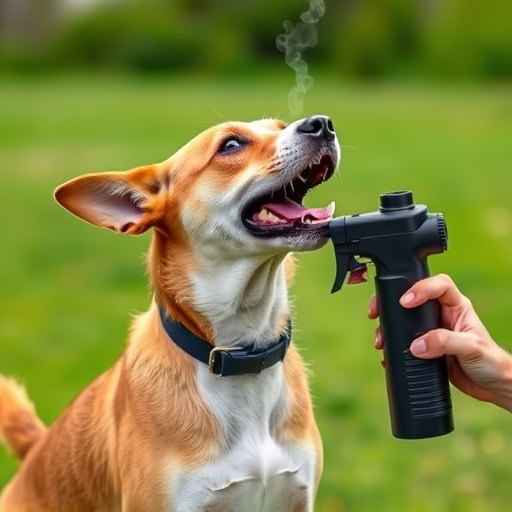Pepper spray, a non-lethal self-defense tool against dog attacks, contains capsaicin from chili peppers and is most effective with proper storage (cool, dry place, away from direct sunlight) and application technique. Storing it in your car glove compartment or center console ensures easy access during walks or hikes, with a typical lifespan of 2-3 years when kept correctly. Always check expiration dates and discard damaged, leaked, or corroded spray immediately. Understand local laws regarding possession and use, as they vary, and only deploy pepper spray as a last resort against an imminent threat. For comprehensive protection, combine pepper spray with obedience training, secure properties, store food safely, and have a specialized first aid kit for dog bites.
“In light of unexpected dog attacks, many individuals are turning to pepper spray as a potential defense mechanism. This comprehensive guide explores the effectiveness of pepper spray for dog attack prevention, delving into its key ingredients and efficacy. We’ll discuss critical storage and shelf life considerations to ensure maximum effectiveness. Additionally, we provide safety tips for carrying and using pepper spray legally, along with alternative strategies like training, prevention, and emergency measures. Discover how these options can help you stay prepared in the car and beyond.”
- Understanding Pepper Spray for Dog Attack Prevention: Key Ingredients and Efficacy
- Storage and Shelf Life Considerations: Maximizing Your Pepper Spray's Effectiveness
- Carrying and Using Pepper Spray: Safety Tips and Legal Aspects
- Alternative Strategies to Pepper Spray: Training, Prevention, and Emergency Measures
Understanding Pepper Spray for Dog Attack Prevention: Key Ingredients and Efficacy
Pepper spray for dog attack prevention has gained popularity as a non-lethal self-defense tool. Understanding its key ingredients and efficacy is crucial when considering it for personal safety. The primary active ingredient in most pepper sprays is capsaicin, derived from chili peppers. This compound irritates the eyes, nose, and respiratory system of dogs, causing them to temporarily become disoriented and retreat.
The effectiveness of pepper spray in preventing dog attacks depends on factors like concentration, application technique, and the sprayer’s proximity to the dog. A typical pepper spray for self-defense has a shelf life of around 2–3 years when stored properly. Storing a can of pepper spray in your car is a strategic move, especially given its potential shelf life. This ensures that it’s readily available during emergencies and remains potent enough for optimal protection.
Storage and Shelf Life Considerations: Maximizing Your Pepper Spray's Effectiveness
When it comes to storing dog attack prevention pepper spray, proper handling is key to maintaining its effectiveness. Keep your pepper spray in a cool, dry place away from direct sunlight and heat sources. Extreme temperatures can degrade the active ingredients over time. Ideally, store it in a designated area within easy reach, like your car glove compartment or center console—a convenient option for quick access during walks or hikes with your dog.
In terms of shelf life, high-quality pepper spray designed for dog attacks typically retains its potency for 2–3 years if stored correctly. Always check the expiration date and follow the manufacturer’s guidelines. Regularly inspect the can to ensure there are no signs of damage, leakage, or corrosion. If the spray becomes discolored or emits an unusual odor, discard it immediately, as these could indicate loss of effectiveness.
Carrying and Using Pepper Spray: Safety Tips and Legal Aspects
Carrying pepper spray as a means of personal defense against dog attacks is a practical strategy, but it comes with safety and legal considerations. It’s crucial to understand that pepper spray is not just for self-defense; its proper use involves ensuring the safety of others around you. Before carrying pepper spray, familiarize yourself with local laws regarding its possession and use, as regulations vary widely. Check if your state or region allows citizens to carry pepper spray for personal protection and what the permitted quantities are.
When storing pepper spray in your car, consider its shelf life. Pepper spray has a limited lifespan; check the expiration date regularly to ensure its potency remains effective. Keep it out of reach of children and pets, in a secure location where you can quickly access it in an emergency. Remember, using pepper spray should be a last resort when facing an imminent threat. Always aim for the eyes, as this area is most sensitive, and be prepared for the possibility of multiple applications if needed.
Alternative Strategies to Pepper Spray: Training, Prevention, and Emergency Measures
While pepper spray is a popular and effective deterrent for dog attacks, it’s important to explore alternative strategies for comprehensive protection. Dog attack prevention goes beyond just carrying pepper spray; it involves a multi-layered approach that includes training and prevention measures.
Regular obedience training can teach dogs basic commands and help them respond calmly in potentially aggressive situations. Additionally, positive reinforcement techniques can foster a trusting relationship between owner and dog, reducing the likelihood of attacks. Preventative measures such as securing your property with fencing and keeping food stored safely can also deter dogs from approaching. In case of an emergency, having a well-stocked first aid kit specifically for dog bites, along with immediate access to water and cold compresses, is crucial for minimizing injury and seeking proper medical attention. Remember too, that pepper spray should be easily accessible in your car, with a known shelf life, to ensure its effectiveness when needed.
In conclusion, while pepper spray can be an effective deterrent against dog attacks, it’s crucial to understand its ingredients, storage needs, legal considerations, and alternative prevention methods. Regularly checking your pepper spray’s shelf life, especially when stored in your car, is essential for maximizing its effectiveness. Combining these safety tips with positive training and preventive measures can help ensure a safer environment for both you and your community.
